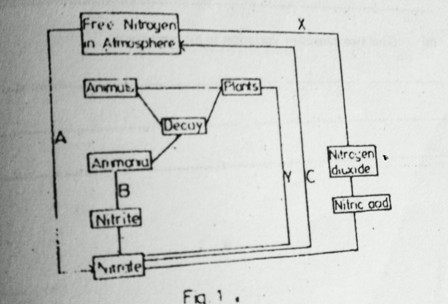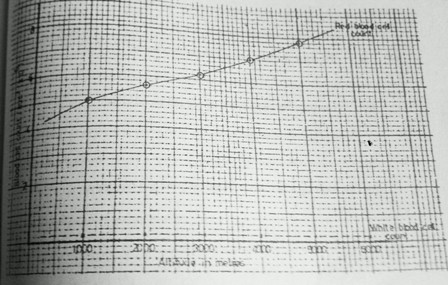PAPER 1
THEORY
SECTION A
Answer all questions in this section. For each question, select the most correct answer and write the letter representing it in the box provided.
1. enzymes are said to be specific in nature because they
A. Are proteins.
B. Act in a particular pH medium.
C. Act on one kind of substrate.
D. Remain unchanged at the end of the reaction.
2. A sample of urine from a man was boiled with Benedict's solution and the mixture turned orange in color. Which of the following is the best deduction about the condition of this man?
A. There was a lot of glycogen in his blood.
B. He has a deficiency of insulin in his blood.
C. His diet has a lot of sugar.
D. His kidneys were damaged.
3. Which of the following will not cause an evolutionary change in an animal species?
A. Having more males than females in the population.
B. Abundant food supply.
C. Presence of many predators.
D. Severe change in environmental conditions.
4. Which of these are characteristic of all insects?
A. Complete metamorphosis and possession of three pairs of joined legs.
B. Possession of three pairs of jointed legs and body divided into three main parts.
C. Possession of one or two pairs of wings and having three pairs of joined legs.
D. Complete metamorphosis and body divided into three main parts.
5. In body temperature regulation, vasoconstriction
A. Allows less blood to enter the skin capillary network.
B. Allow less urine to be secreted into the bladder.
C. Allows more sweat to be secreted by the sweat glands.
D. Increases heat loss by radiation.
6. Which type of soil has the following properties?
(i) Heavy to cultivate.
(ii) High water retention.
(iii) High capillarity
A. Sandy loam
B. Loam
C. Sand
D. Clay
7. The main function of the Eustachian tube in the mammalian ear is to
A. Concentrate the sound waves into the middle ear
B. Transmit sound waves to the brain
C. Transmit sound waves to the middle ear
D. Regulate pressure in the middle ear
8. Which one the following results of seed dispersal may not be an advantage to a plant?
A. Reduces overcrowding
B. Minimizes spread of disease
C. Stops competition for light and air
D. Results in colonization of new areas
9. A heterozygous red flowered plant is crossed with a homozygous white flower. If red is dominant over white, what will be the phenotypes of the offspring?
A. ½ red and ½ white
B. All white
C. All red
D. ¾ red and ¼ white.
10. Which of the following is the best description of the term double circulation in a mammal?
A. Blood flows into the two lungs and then into the body.
B. Blood passes through two chambers of the heart
C. Blood passes through the heart twice in one circulation.
D. Blood first flows through arteries and then through veins.
11. Which one of the following is an example of a tactic response?
A. Rolling up of leaves on a sunny day.
B. Withdrawal by blowfly larvae from light.
C. Withdrawal of the hand from a hot object.
D. Bending of a plant shoot towards light.
12. The best method that prevents the start of gully erosion on a cultivated hill is
A. Contour cultivation.
B. Strip cropping
C. Tree belts
D. Mulching
13. An adult person who constantly feeds on an iodine deficient diet may show one of the following conditions:
A. Anaemia
B. Goiter
C. Cretinism
D. Dry scaly skin
14. In the flowering plants translocation of photosynthetic products is by the
A. Xylem vessels.
B. Scelerechyma
C. Sieve tubes
D. Companion cells
15. In which part of the gut does mucus (mucin) have a protective function?
A. Oesophagus
B. Stomach
C. Small intestine
D. Rectum
16. The main function of luteinizing hormone in the reproductive cycle of a mammal is that it
A. Causes ovulation
B. Causes thickening of the uterine walls
C. Initiates the growth of a graafian follicle
D. Maintains pregnancy for the first 3 months.
17. During seed germination, the dry weight initially decreases because
A. Stored food is used up for growth and respiration.
B. Soluble food materials diffuse out of the seedlings
C. Rate of water absorption is low
D. Rate of cell division is low.
18. A sample of blood from the hepatic portal vein contains.
A. Fats
B. Proteins
C. High concentration of urea
D. High concentration of products of digestion
19. Which of the following does not affect the rate of diffusion?
A. Density of the diffusion medium
B. Size of diffusing particles
C. Distance through which particles diffuse
D. Temperature of the diffusion medium
20. The function of amniotic fluid in foetal development is
A. Protection of the foetus from shock
B. Transfer of nutrients from mother to foetus
C. Allowing gaseous exchange between mother and foetus
D. Prevention of dangerous substances from reaching the foetus
21. Which of the following is not a component of joints in the endoskeleton?
A. Cartilage
B. Tendon
C. Ligament
D. Synovial fluid
22. Which one of the following structures represents the respiratory surface of a fish?
A. Gill bars
B. Gill rakers
C. Gill chamber
D. Gill filaments
23. Meiosis normally results in
A. Halving the number of chromosomes
B. Production of identical cells
C. Maintaining the number of chromosomes
D. Propagation of new organisms.
24. Which of these statements is not true of an ecosystem?
A. Consumers use less food compared to what producers make.
B. One of the ways of constructing a food chain is by observing the animals feeding.
C. The numbers of organisms decrease from the bottom to the top of the pyramid of numbers.
D. Because of mains feeding habits, he can be placed in any of the feeding levels.
25. In humans, the male sex chromosomes are X and Y (XY) and the female sex chromosomes are X and X (XX). When a male gamete fuses with a female gamete the sex ratio is
A. 1: 2
B. 1:3
C. 1:1
D. 1:4
26. Artificial immunity to a disease is developed by
A. Catching the disease and recovering from it.
B. Inoculation with a mild strain of the pathogen.
C. Receiving antibiotic injections against the disease.
D. Taking drugs that prevent the disease.
27. Which one of the following is an example of discontinuous variation in humans?
A. Skin color
B. Intelligence
C. Height
D. Blood groups
28. What are the final products of anaerobic respiration?
A. Carbon dioxide, water and energy
B. Carbon dioxide, water and alcohol
C. Carbon dioxide, alcohol and energy
D. Carbon dioxide and alcohol
29. Which one the following is characteristic of monocotyledons?
A. Leaf sheath
B. Net venation
C. Prominent tap root
D. Cork layer
30. What is the functional unit in a nervous system called?
A. Dendrite
B. Neuron
C. Axon
D. Synapse
SECTION B
Answer all questions in this section. Answers must be written in the spaces provided.
31. The table below shows the effect of temperature on the activity of amylase on starch. Six test tubes, each containing a mixture of starch and amylase, were placed in water baths maintained at 00C, 100C, 200C, 300C, 400C and 500C and allowed to stand. Study the table and answer the questions that follow.
| Test tube | Temperature (0C) | Time taken for starch digestion (minutes) |
|
1 2 3 4 5 6 |
0 10 20 30 40 50 |
starch still present after 60 minutes 22 11 5 3.5 starch still present after 60 minutes |
a) How does temperature affect the action of amylase?
b) Give one reason in each case for the results obtained in the tubes kept at
(i) 00C
(ii) 500C
c) Suggest the time it would take amylase to digest starch if the temperature is kept at 00C.
d) Describe the test you would carry out to determine the substance into which the starch has been broken.
32. a) Give three ways of maintaining soil fertility.
b) State four ways by which soil organisms contribute to soil fertility.
c) The scheme below represents the nitrogen cycle. Study it carefully and answer the questions that follow.

(i) Give the general names of the bacteria represented by letters A, B and C.
A .............................................................................................................
B .............................................................................................................
C .............................................................................................................
(ii) Name the process labelled X and Y.
X ............................................................................................................
Y ............................................................................................................
(iii) On the diagram show by means of arrows, the direction of the processes along the lines.
33. a) in the study of evolution, state what is meant by
(i) a vestigial organ,
(ii) a fossil,
(iii) variation
b) Give two causes of variation in an organism.
c) How has the knowledge of variation helped farmers to improve on their production?
34. The graph below shows the results of blood cell counts taken on people living at different altitude. The counts are expressed in terms of blood cells per mm3 of blood.

a) What were the red blood cell counts at
(i) 250m
(ii) 5600m?
b) State and explain the relationship between altitude and red blood cell count.
c) Why did the white blood cell count show no change?
d) (i) Where in the body are red blood cells made?
(ii) How does the body deal with old blood cells?
e) Give two ways by which white blood cells defend the body.
SECTION C
Answer any two questions from this section.
35. A child sees a fierce looking dog, gets frightened and runs. Describe the sequence of events leading to the child's reaction.
36. a) What is pollination?
b) Describe the processes that place after pollination in a flowering plant.
c) Give three differences between insect pollinated and wind pollinated flowers.
37. a) Giving two examples in each case, explain what you understand by the terms.
b) How are parasites adapted to their mode of life?
38. a) Why do flowering plants posses simpler excretory organs that those found in mammals?
b) Describe how the mammalian kidney forms urine?
c) What part is played by the mammalian skin in excretion?
